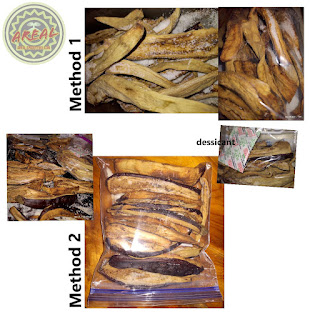Sproutfuel.AREAL.com considered energy use in the methods below.
Other drying recipes involve using the oven 10-12hrs on low with the door open.
Method 1 takes 3 weeks and is preferred for rehydrating for cooked dishes without skin or stem.
Method 2 takes 3-4 days and is better for quick snacks. Plainstyle "eggplant jerky"- you can add your own marinade step or dip in your favorite oil with herbs. This should be kept out in the open. ziploc it only for a road-trip, hike, etc. unless you plan to refrigerate it. This doesn't keep too long.
Method 2 was used with peeled, partially peeled, and unpeeled Nasu and works for all 3 preferences.
---
Method 1
3 weeks - no dehydrator - open-air (oven optional) - Room temperature is 50-60F
1. Rinse fruits thoroughly.
2. Peel and cut into 1/2 inch thick x 1"-2" wide slices - up to the length of the fruit.
(optional to salt and rinse nasu after 1-2 hours)
3. set out on a drying rack or net for 2-3 weeks in a well-ventilated area
4. check on them every 1-2 days for mold and rotate 2-3 times a week
4a. If there is any mold (1): AFTER removing the non-moldy pieces, THEN toss away the moldy pieces and sterilize everything on the drying rack.
5. (extra step)- put the pieces in a dry unoiled metal bread pan and bake out (250-300F) any remaining moisture in 5-7min or longer- if using these for a type of jerky. Let cool completely before storing.
6. put in a storage jar or bag and add salt 1tbsp+ and a sealed desiccant envelope.
Method 2 (plain jerky - no marinade)
3-4 days: - no dehydrator - open-air and oven - more traditional cutting
1. Rinse fruits thoroughly
2. Cut fruit lengthwise (2times into Quarters) or (3 times into 6ths) keep pieces attached to the stem
(optional step to sprinkle with Salt and rinse nasu after 1-2 hours)
3. Hang them over a string/clothesline and air dry for 1-3 days - though 2 days is enough
4. Check on them every day for any mold development
4a. If there is any mold: AFTER removing the non-moldy pieces, toss away the moldy pieces and sterilize everything before returning it to dry- or move to oven step 5
5. Preheat the oven (day 3 drying) to 250F - put the trimmed pieces on parchment on flat baking sheets.
Add the sheets to the oven for 1.5-2 hours and bake. Turn off the oven and let air dry overnight.
6. Preheat the oven (day 4 drying) to 350F - 1.5-2 hours - to desired dryness for jerky. (it's ok to roast other veggies during this 2nd drying time)
7. put in a storage jar or bag and add salt and a sealed desiccant envelope.
Other options for excess nasu:
If freezer space is ample: You can simply blanch the cut fruit 5-7min in boiling water, drain it, and separate it with parchment or wax paper, and freeze in bags or freezer containers. Blanching and freezing is the quickest way to store Nasu to make "fresher" looking dishes or to keep the grilled look.
If the cabinet or shelf space is ample: The most traditional Japanese way to use Nasu or extra veggies is to make traditionally flavored tsukemono. Pickling is a long process and is wonderful to do with time and love.
Quality: A firm homegrown fruit is preferred.
Sometimes, the ripened berry will have brown spots on the skin surface and look "old". Frequently, these ugly fruits are passed over while the interior is still perfect. Only throw it away when the exterior is rotted, moldy, or has broken skin from an unknown source. Some people use the 'good parts' of a not-so-great fruit. Though this nightshade berry is already toxic, any mold is an additional toxin.
White Mold:
On the drying rack sometimes a white mold such as sclerotinia sclerotiorum will grow on the outside of cut fruit or veggies. It can be prevented by adding selenium to soil (2) during plant growth. On produce, you might find it growing after 1-2 days of drying even with good air circulation and washing the veggies. Why some store-bought produce pieces are moldy while others appear to be pristine is still a mystery. Though it's possible that mold contamination gets below the skin's surface during processing in a wash or rinse cycle. It's important to know that this common plant mold is a toxin and its spores are what catalyst the growth. Be sure to take precautions and clean and sterilize your kitchen tools if you run into them in the dehydrator, countertop, etc.
References:
1. Noda Y, Kaneyuki T, Igarashi K, Mori A, Packer L. Antioxidant activity of nasunin, an anthocyanin in eggplant. Res Commun Mol Pathol Pharmacol. 1998 Nov;102(2):175-87. PMID: 10100509.
https://pubmed.ncbi.nlm.nih.gov/10100509/
2. White Mold website: https://www.apsnet.org/edcenter/disandpath/fungalasco/pdlessons/Pages/WhiteMold.aspx
3. 31394376.https://pubmed.ncbi.nlm.nih.gov/31394376/
Cheng Q, Hu C, Jia W, Cai M, Zhao Y, Tang Y, Yang D, Zhou Y, Sun X, Zhao X. Selenium reduces the pathogenicity of Sclerotinia sclerotiorum by inhibiting sclerotial formation and germination. Ecotoxicol Environ Saf. 2019 Nov 15;183:109503. doi: 10.1016/j.ecoenv.2019.109503. Epub 2019 Aug 5. PMID:


10 Free Spins at the UK Casino | No Deposit Bonuses UK 2021
ReplyDeleteIt has also been voted the best 온카지노 online casino 온카지노 in the 우리카지노 쿠폰 UK in the number of slots, table games and bingo games. The choice of these can help